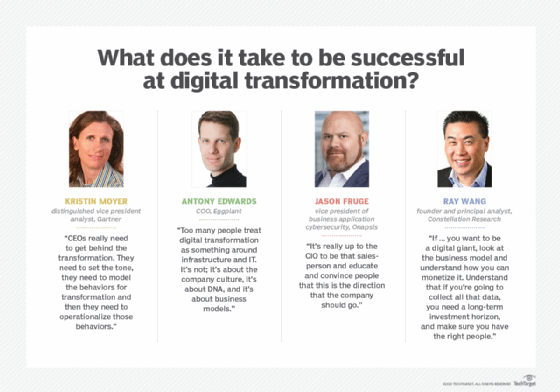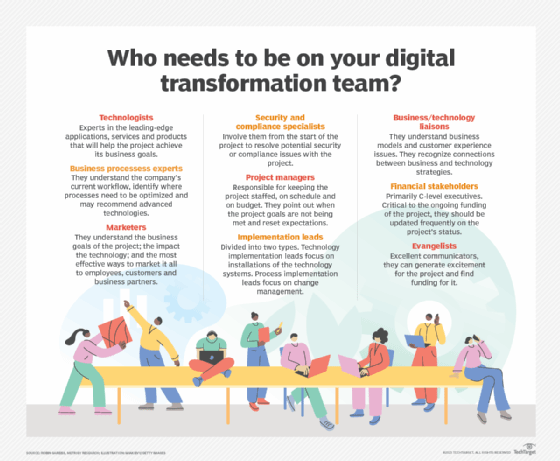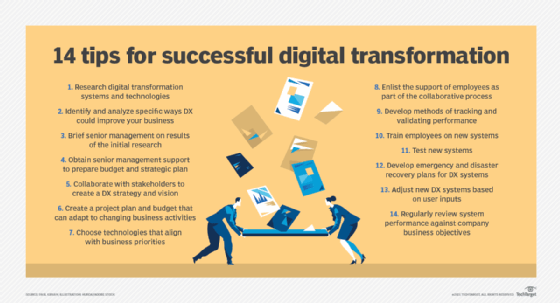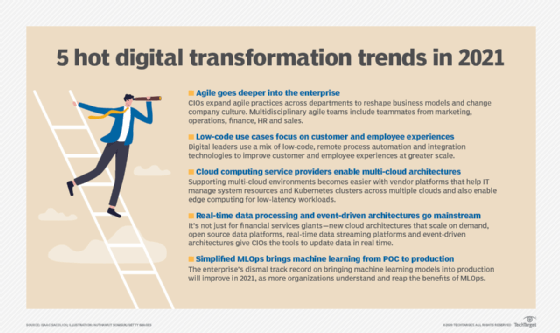Ultimate guide to digital transformation for enterprise leaders
This in-depth guide explains what digital transformation is, why it is important and how enterprises can successfully transition to this new business paradigm.
Digital transformation is a global business phenomenon, capturing the attention of enterprises in every industry and spurring major investment. In survey after survey, heads of companies cite digital transformation as their No. 1 concern. By 2023, the digital transformation market is expected to reach $6.8 trillion, according to research firm IDC, and 75% of organizations will have a comprehensive digital transformation roadmap in place -- up from 27% of companies today.
The term digital transformation is broadly defined as the use of computer-based technologies to improve an organization's performance. Dismissed as just a buzzword for many years, digital transformation has become palpable and urgent: Of the companies surveyed in the most recent Digital Vortex study, 88% said digital disruption will have a major impact on their industries; 41% of those respondents said disruption was imminent.
The question might be asked, what took so long? The so-called SMAC technologies that sparked the digital business revolution -- social media, mobile, analytics and cloud computing -- appeared on corporate radars more than a decade ago. Today's digital giants did not become the world's most powerful companies overnight. Amazon has been schooling enterprise leaders on the value and disruptive power of online customer engagement since it put Borders out of business in 2011. That was also the year Apple sold 72 million mobile phones -- well on its way to the 213 million units sold in 2015, its peak year. In 2011, Marc Andreessen's paean to software-based companies, "Software is eating the world," was published in The Wall Street Journal.
One explanation for business's slow pivot lies in what makes the information technologies of the digital age different from technologies that fueled other business transformations. They evolve, seemingly, at warp speed. New software can be built and distributed quickly relative to, for example, a mechanical contrivance that requires tooling up a factory, and once the code is there it can be customized endlessly -- provided that a business has the right talent and corporate culture in place. That is not the case for many companies. At traditional enterprises, perhaps especially those companies with millions of dollars invested in legacy technology, digital transformation was viewed as a disruption to be avoided or best executed in small steps.
A pandemic disrupts
COVID-19 radically changed that mindset as enterprises scrambled to enable remote work and serve customers in lockdown in order to keep their businesses afloat. Practically overnight, digital transformation was a matter of survival.
"It woke up a lot of C-suite officers, alerting them to stop dragging their feet on their digital transformation efforts, because they saw that the companies that were more mature in their digital transformation suffered much less disruption and much less costly disruption," said Rick Pastore, senior research director at consultancy firm The Hackett Group.
The switch flipped. According to a recent Gartner survey, more than two-thirds of boards of directors accelerated their digital business initiatives in the wake of COVID-19 disruption, and about half foresee changing their organizations' business models as a result of the pandemic.
But make no mistake, digital transformation per se is disruptive: Emerging technologies such as AI, IoT, robotic process automation (RPA) and edge computing open up entirely new business opportunities and give rise to completely new customer expectations. Companies with the resources and mindset to take the leap gain a competitive advantage, widening the gap between digital laggards and leaders.
SearchCIO's comprehensive guide to digital transformation in the enterprise is here to help. We break down the nuts and bolts of this business revolution -- what it is and why it's important across industries, its business benefits and its challenges. Throughout the guide, there are hyperlinks to in-depth explanations of these topics and to step-by-step prescriptions on how to develop a digital transformation roadmap, plan a budget, field a digital transformation team, measure and improve ROI, and more.

What is digital transformation?
Digital transformation is the incorporation of computer-based technologies into an organization's products, processes and strategies. Which digital technologies are used and why, how they are implemented and what will be gained from their implementation differs from company to company, making a simple characterization of digital transformation virtually impossible. As technology writer Mary Pratt reports in her detailed definition of digital transformations, these initiatives can be very wide in scope, entailing the examination and reinvention of all facets of an organization, from supply chains and workflow, to employee skill sets and org charts, to customer interactions. Whatever the scope, there are primarily two drivers of digital transformation: optimizing an enterprise's workflow and expanding its market.
Why is digital transformation important?
"With optimization, the outcomes you're getting are things like improved efficiency and improved engagement with customers," Gartner analyst Kristin Moyer told technology writer Mekhala Roy in an article on examples of digital transformation success. "With transformation, what you're focusing on is brand-new revenue -- for example, new digital products and services and new business models."
While optimization and growth have always been main drivers of business success, the growth and efficiencies enabled by digital technologies are potentially as impactful as the business changes spurred by the Industrial Revolution, making digital transformation critically important. Advantages of digital technologies include the following:
- Companies that are able to incorporate digital technologies into products and processes become nimbler.
- Software is easier to modify than retooling a factory.
- Going after a new set of customers online is easier than going to their homes or convincing customers to travel to your stores.
- Unlike humans, AI systems and RPA can work 24/7 without benefits, raises or arbitration.
At medical device maker Zimmer Biomet, CIO Zeeshan Tariq said RPA bots were on track to hit 50,000 productivity hours in 2020. Speaking on a virtual panel of CIOs at last year's MIT Sloan CIO Symposium, he described the company's transition to AI and RPA as "truly revolutionary."
According to research from consultancy BCG, the earnings growth for digital leaders is 1.8 times higher than for digital laggards -- "and more than double the growth in total enterprise value." The companies profiled in the aforementioned article on examples of digital transformation success -- Domino's Pizza, Capital One, Walmart and Tesla -- attest to the value of transitioning to a digital environment and show the various ways to achieve it.
In Domino's case, the transformation effort was multipronged and multiyear. It began in 2008 when the pizza chain saw its stock plummet and was focused on technology infrastructure modernization as well as the use of AI and machine learning to improve product quality. The chain's digital transformation journey not only delivered better products more conveniently, it propelled a meteoric 2,000%-plus rise in the company's stock price.

Main areas, benefits of digital transformation
The projected ROIs for digital transformation initiatives will vary from one program to another and enterprise to enterprise, but experts said that incorporating digital technologies brings the following overarching benefits -- all interrelated and interdependent:
- increased efficiency and productivity
- better resource management
- more resiliency
- greater agility
- improved customer engagement
- increased responsiveness
- greater innovation
- faster time to market
- increased revenue
- continued relevancy
Learn about how digital technologies deliver these benefits in Pratt's article, "Top 10 digital transformation benefits for business."
What are the biggest challenges of digital transformation?
Just as the benefits of digital technologies are demonstrated daily by companies that have cracked the code, so are digital transformation's well publicized and sobering failure rates. For instance, according to one oft-cited study, 70% of all digital transformation initiatives do not reach their goals; of the $1.3 trillion spent on digital transformation in 2018, an estimated $900 billion went to waste.
The journey to digital transformation is paved with challenges. Roadblocks not only abound, but they can also change rapidly and will differ depending on where you are in your journey to becoming digital, explained consultant Isaac Sacolick. A former CIO whose Driving Digital: The Leader's Guide to Business Transformation Through Technology was an Amazon bestseller, Sacolick has found the main challenge for CIOs starting out on transformation programs is getting business heads and decision-makers to agree on a digital strategy. For IT organizations experienced in developing and deploying new technologies, the main challenge is often cultural: providing a way that makes it easy for "people across the organization to take advantage of new digital capabilities and to sunset legacy processes."
Sacolick identified three major tests CIOs will face in the coming year as they pursue their digital transformation objectives:
- COVID-19 has spurred new customer needs and new expectations, particularly in retail. The vast majority of shoppers say they will continue to shop online even after the pandemic and prefer shopping in stores with touchless or robust self-checkout options.
- Gaps persist in technical expertise and technology integration skills.
- Old organizational structures and leadership styles hinder digital transformation success.
Read his article, "3 biggest challenges of digital transformation in 2021," for a detailed analysis of these challenges and how to solve them.
What is the role of technology in digital transformation?
One of digital transformation's truisms is that it is not about technology; a fuller explanation is that it's not only about technology. Having a vision and roadmap is a given. Culture plays a huge role in digital transformation success. Having leaders who understand the business and cutting-edge technologies well enough to know where digital can -- or can't -- help a company is also critical. More on these points later.
One thing is clear: Technology is absolutely necessary for digital transformation -- it is the engine and enabler of this 21st-century business revolution. Here is a snapshot of some key technologies and their roles:
- Cloud computing gives quicker anytime, anywhere access to software, new functions and updates along with data storage and scalability.
- Commoditized IT frees up resources to develop differentiating software customization.
- Mobile platforms enable anytime, anywhere access for employees and customers.
- Machine learning and AI provide faster data-driven decisions and continuous improvement to automated systems.
- RPA uses bots to perform routine repetitive tasks faster and with less error than humans.
- Emerging technologies such as blockchain, augmented reality and virtual reality, IoT and edge computing offer new ways of taking advantage of the explosion of digital data generated by enterprises and customers.
Another truism is that deploying technology for technology's sake is a recipe for failure. Successful IT leaders make the connection between technology and business goals. Not only do they deeply understand how a particular technology can drive the business, they delve into the corporate hierarchies and politics that can hinder adoption of the new technology-driven capabilities.
Speaking about Zimmer Biomet's massive RPA deployment and other technology initiatives, CIO Tariq told SearchCIO his team makes "a clear and measurable success criterion ahead of making any technology investment." But the vetting doesn't stop there. "Once a technology is selected, we invest meticulously in organization change management, ensuring organizational readiness to extract optimal value from technology investments," he said.
Because of technology's essential role in digital transformation, Sacolick said that in 2021 it's imperative CIOs "shift from a reactive posture to a proactive" leadership style to accelerate their businesses' digital transformation initiatives. This will mean helping business colleagues develop new digital business models and taking a lead role in fostering a corporate culture that prioritizes experimentation and appreciates how digital technologies can confer a competitive advantage.
Digital transformation roadmaps and frameworks
Dealing with the panoply of digital technologies that can potentially drive business performance is daunting. It's important to have a framework and clear roadmap for transitioning to a digital environment. In "How to build a digital transformation roadmap in 6 steps," independent IT consultant Paul Kirvan lays out a detailed step-by-step process applicable to any organization.
At Truist Bank, CIO Scott Case said having clear and concrete objectives for moving to a digital environment is crucial. Truist is the sixth-largest bank holding company in the U.S. as a result of the December 2019 merger of SunTrust and BB&T, and it is lauded for its mobile app capabilities.
"We spend a lot of time at Truist talking about what do we mean by digital and what do we mean by digital transformation," said Case, who joined SunTrust in 2015 as CTO, was named CIO in 2018 and became CIO of the combined company in 2019, overseeing a several thousand-strong IT team.
He said Truist's digital transformation framework is underpinned by the bank's mission -- "to inspire and build better lives and communities" -- and driven by a framework that includes multiple "pillars." The safety, soundness and resilience of the bank's operating technology are "table stakes," Case said. Modernization of IT infrastructure, software architecture and data analytics platforms are key pillars. Elements of the Truist roadmap include the following:
- automating data centers using software-defined networks;
- using cloud architecture's speed, resilience and security features to drive transformation, which includes but is not synonymous with exporting data to the public cloud ("We are very clear here about distinguishing architecture from the destination of the data," Case said);
- adopting an API framework for safely moving data back and forth among "core ecosystems" and delivering data securely to any device of choice;
- speeding up the delivery of software through the implementation of continuous integration and continuous delivery (CI/CD); and
- organizing data so that it can be consumed by multiple teams, including cybersecurity, operations and call centers.
One Truist pillar that is not specifically about technology but is absolutely crucial, Case said, is modernizing how people work. It requires business partners who are willing to collaborate with IT, technology leaders who see themselves as partners to the business, and creative and talented developers. "Assembly-line delivery of software is no longer what we do," he stressed. Having dedicated employees pulling in the same direction is also crucial. "That's when the flywheel starts to spin faster," he said. "That's where the beauty of digital transformation comes to life."
Who leads digital transformation, who's on the team?
Assembling the right team for a digital transformation project is critical. According to Robin Gareiss, CEO and principal analyst at strategic advisory firm Metrigy, it is the single most important component of a digital transformation strategy and possibly the leader's hardest job. That's because so many skills must be taken into consideration for each team member, including the person's education, experience and ability to influence and work with others. Transformation is a team sport. Finding talent with the specific, required skills is "one of the biggest challenges in digital transformation projects," Gareiss said.
Who leads the team, on the other hand, is relatively straightforward. Digital transformation leaders are "typically C-level executives with budget, influence and respect," she said. At some companies, they have titles such as chief digital officer or chief strategy officer, and their only role is to digitally transform the company. At other companies, the CIO, CTO or COO takes the helm, leading digital transformation along with discharging their other responsibilities. In both cases, it is typically the CEO who appoints the person in charge of the digital transformation initiative.
In her article, "Building a digital transformation team: 8 essential roles," Gareiss lays out the crucial positions for a digital transformation team and explains each role's importance. An individual role will likely need multiple people working in that capacity, she explained. The graphic below provides a thumbnail view of the roles.

Tips for developing a successful digital transformation strategy
What constitutes digital transformation success? Is it a complete migration to the technologies supporting digital business? The implementation of advanced customer relationship management platforms? Increased revenue and market share? In IT consultant Paul Kirvan's view, the latter "is the acid test, as the primary reason for migrating to a digital transformation environment must ultimately be to improve the business."
Improvement might encompass delivering a better customer experience, or increasing productivity, eliminating inefficiencies, ensuring compliance and so on, Kirvan said. But realizing those business benefits will not happen overnight, he stressed, and will depend on many factors discussed in this guide -- from the dedicated involvement of business leaders, to a solid understanding of how advanced technologies such as AI and machine learning can be used. In his detailed primer on developing and executing a successful digital transformation strategy, Kirvan lays out 14 need-to-know tips. The illustration below provides a glimpse of what enterprises need to do.

Digital transformation budgeting and ROI
Preparing and securing a budget is a key component of any transformation project. Metrigy's Gareiss said it is important to understand that budget planning for transformation projects follows different processes from traditional budget planning.
For starters, traditional IT budgeting is fairly consistent year over year, Gareiss explained, with stakeholders requesting increases based on the previous year's operational and capital budgets. Traditional budgets typically cover technologies required to "keep the lights on" and deliver services that employees need to do their jobs. Upgrades and replacements are planned years in advance and based on (usually) stable employee counts. "There are few unknowns, and the budgeting follows the same predictable model year after year," she said.
Because digital transformation projects break new ground, there are many unknowns that business budget deciders will need to consider. There's also plenty of politics and obscure pots of money to be tapped. An ability to roll with the punches is a big plus. Gareiss offers her advice on how to navigate the rough waters in "6 tips for digital transformation budget planning." As digital transformation projects accelerate and increase in scope, demonstrating a compelling ROI is vital to earning support and funding for additional digital initiatives. Gareiss' companion article outlines nine steps for measuring and improving digital transformation ROI.
Why digital transformations fail
Digital transformation is essential to business survival, but companies keep failing at it. Antony Edwards, COO at software testing and monitoring company Eggplant, believes he knows why.
"Too many people treat digital transformation as something around infrastructure and IT. It's not; it's about company culture, it's about DNA and it's about business models," Edwards told writer Mekhala Roy. "And if you don't approach it from that kind of business and customer perspective, it's going to fail."
Gartner's Moyer buckets digital transformation failures into three categories:
- Regression, or "transformation-washing." Businesses say they are transforming but are just doing what they should have done years ago, like developing a webpage that is more than just an online brochure.
- Underperformance. Businesses go small and underestimate the value they can reap from a transformation initiative. They still get value from their efforts, just not as much as they could have.
- Failure of a new digital product or service. The particular innovation is a bust and the company has to discontinue it.
The reasons behind these types of digital transformation failures and what can be done to avoid them are detailed in Roy's article, "Top 6 reasons why digital transformation failures happen."

The future of digital transformation
Businesses should pay attention to five digital transformation trends in the coming year, according to Sacolick. The first pertains to universalizing agile practices. The second trend is the continued growth of low-code platforms, enabling inexperienced employees to create business apps. Third, cloud computing service providers will support multi-cloud architectures. Fourth, real-time data processing will go mainstream. And fifth, simplified machine learning operations -- the collaboration of data scientists and IT pros to automate machine learning algorithms -- will take hold.
In the short term, businesses will find plenty of resources to help them plot their digital transformation journeys. In addition to the scores of articles advising companies how to move forward with digital transformation, there are top-notch online courses for IT and business people alike, and a steady stream of books: Here are 10 top titles to consult when looking for help in the near term.
And in the long term? A definition of digital transformation by Sanjay Srivastava, chief digital officer at Genpact, is instructive: "Digital transformation gives you the agility needed to adapt to changes in the environment to deliver value even in the long run and to stay relevant for the industry you're in."
Eventually digital transformation will be complete. What's next? Maybe quantum transformation?
Latest digital transformation news and trends
Microsoft slammed for hitting European cloud users with 'unfair, additional' charges
Research from non-profit Cloud Infrastructure Services Providers in Europe organization suggests cost of digital transformation is going up for 'unfair' reasons. Read more
Enterprise software price hikes risk derailing digital transformation
Buying software and cloud services for strategic initiatives is all very well as long as the price is stable. But costs are escalating, which is impacting value. Read more
Partners: IT investment balances innovation, optimization
IT service executives expect to see customers pursue the transformative potential of AI and cloud in the second half of 2023 -- while keeping a close watch on costs and results. Read more
How CIOs overcome internal resistance to digital transformation
Modernization requires realigning company culture to support innovation -- and executive leadership can drive that change. Read more
The impact of digital transformation on workplace trends
Explore the digital trends transforming the workplace, from AI and hyperautomation to smart offices and cloud storage. Read more








